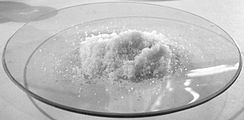Ammonium carbonate

| |

| |

| |
| Names | |
|---|---|
| IUPAC name
Ammonium carbonate
| |
Other names
| |
| Identifiers | |
3D model (JSmol)
|
|
| ChemSpider | |
| ECHA InfoCard | 100.007.326 |
| EC Number |
|
| E number | E503(i) (acidity regulators, ...) |
PubChem CID
|
|
| UNII | |
| UN number | 3077 |
CompTox Dashboard (EPA)
|
|
| |
| |
| Properties | |
| (NH4)2CO3 | |
| Molar mass | 96.09 g/mol |
| Appearance | White powder |
| Density | 1.50 g/cm3 |
| Melting point | 58 °C (136 °F; 331 K) |
| Boiling point | Decomposes |
| 100g/100ml(20°C),decomposes in hot water | |
| -42.50·10−6 cm3/mol | |
| Hazards | |
| Occupational safety and health (OHS/OSH): | |
Main hazards
|
Irritant |
| GHS labelling: | |

| |
| Warning | |
| H302, H319 | |
| Safety data sheet (SDS) | External MSDS |
| Related compounds | |
Other anions
|
Ammonium bicarbonate Ammonium carbamate |
Other cations
|
Sodium carbonate Potassium carbonate |
Except where otherwise noted, data are given for materials in their standard state (at 25 °C [77 °F], 100 kPa).
| |
Ammonium carbonate is a salt with the chemical formula (NH4)2CO3. Since it readily degrades to gaseous ammonia and carbon dioxide upon heating, it is used as a leavening agent and also as smelling salt. It is also known as baker's ammonia and was a predecessor to the more modern leavening agents baking soda and baking powder. It is a component of what was formerly known as sal volatile and salt of hartshorn.[1]
Production
Ammonium carbonate is produced by combining carbon dioxide and aqueous ammonia. About 80000 tons/year were produced as of 1997.[1]
Decomposition
Ammonium carbonate slowly decomposes at standard temperature and pressure through two pathways. Thus any initially pure sample of ammonium carbonate will soon become a mixture including various byproducts.
Ammonium carbonate can spontaneously decompose into ammonium bicarbonate and ammonia:
- (NH4)2CO3 → NH4HCO3 + NH3
Uses
Leavening agent
Ammonium carbonate may be used as a leavening agent in traditional recipes, particularly those from northern Europe and Scandinavia (e.g. Speculoos, Tunnbröd or Lebkuchen). It was the precursor to today's more commonly used baking powder.
Originally made from ground deer horn and called hartshorn. Today it is called Baker's Ammonia. The ingredient ammonium carbonate is a mix of ammonium bicarbonate (NH4HCO3) and ammonium carbamate (NH2COONH4). It is prepared by the sublimation of a mixture of ammonium sulfate and calcium carbonate and occurs as a white powder or a hard, white or translucent mass.[2] It acts as a heat activated leavening agent and breaks down into carbon dioxide (leavening), ammonia (which needs to dissipate) and water. It is sometimes combined with sodium bicarbonate to mimic as a double acting baking powder and to help mask any ammonia smell not baked out.
It also serves as an acidity regulator and has the E number E503. It can be replaced with baking powder, but this may affect both the taste and texture of the finished product. Baker's ammonia should be used to create thin dry baked goods like crackers and cookies. This allows the strong ammonia smell to bake out. It should not be used to make moist baked items like cake since ammonia is hydrophilic and will leave a strong bitter taste.
Its use as a leavening agent, with associated controversy, goes back centuries:
In the third kind of bread, a vesicular appearance is given to it by the addition to the dough of some ammoniacal salt, (usually the sub-carbonate,) which becomes wholly converted into a gaseous substance during the process of baking, causing the dough to swell out into little air vessels, which finally bursting, allow the gas to escape, and leave the bread exceedingly porous. Mr. Accum, in his Treatise on Culinary Poisons, has stigmatized this process as "fraudulent," but, in our opinion, most unjustly. The bakers would never adopt it but from necessity: when good yeast cannot be procured, it forms an admirable and perfectly harmless substitute; costing the baker more, it diminishes his profit, while the consumer is benefited by the bread retaining the solid matter, which by the process of fermentation is dissipated in the form of alcohol and carbonic acid gas.[3]
Other uses
Ammonium carbonate is the main component of smelling salts, although the commercial scale of their production is small. Buckley's cough syrup from Canada today uses ammonium carbonate as an active ingredient intended to help relieve symptoms of bronchitis. It is also used as an emetic. It is also found in smokeless tobacco products, such as Skoal, and it is used in aqueous solution as a photographic lens cleaning agent, such as Eastman Kodak's "Kodak Lens Cleaner."
Substitute
A teaspoon of baker’s ammonia can be substituted with a teaspoon baking powder plus a teaspoon baking soda.[citation needed]
See also
- Ammonium bicarbonate
- Ammonium nitrate
- Sal ammoniac, the mineralogical form of ammonium chloride
References
- ^ a b Karl-Heinz Zapp "Ammonium Compounds" in Ullmann's Encyclopedia of Industrial Chemistry 2012, Wiley-VCH, Weinheim. doi:10.1002/14356007.a02_243
- ^ "CFR - Code of Federal Regulations Title 21". www.accessdata.fda.gov. Retrieved 2018-02-07.
- ^ "Bread". The Engineer's and Mechanic's Encyclopedia. Vol. 1. Luke Hebert. 1849. p. 239.
